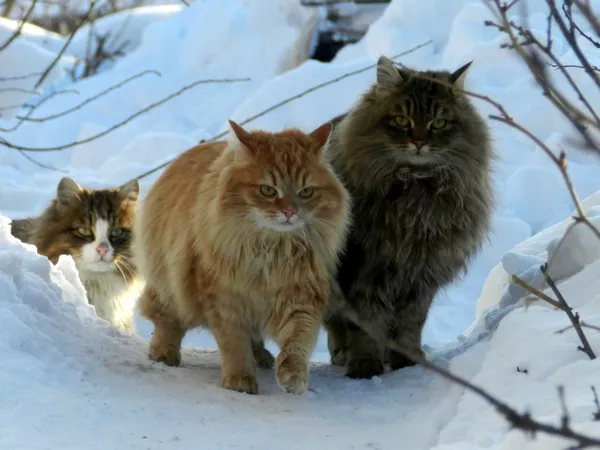Norwegian Forest Cats, with their majestic appearance and captivating personalities, are a unique and treasured breed among cat enthusiasts. Known for their strong, muscular build, luxurious fur, and affectionate nature, these cats make wonderful companions. However, like all pets, Norwegian Forest Cats require proper care and attention to thrive. One common concern among cat owners is whether it’s acceptable to leave a Norwegian Forest Cat alone for extended periods. In this comprehensive article, we will explore the characteristics of Norwegian Forest Cats, their need for social interaction, and strategies for ensuring their well-being when left alone.
The Norwegian Forest Cat Breed Overview
Before we delve into the topic of leaving Norwegian Forest Cats alone, it’s essential to understand the basics of the breed. Norwegian Forest Cats, often referred to as “Wegies,” are a natural breed that originated in the forests of Norway. Here are some key characteristics of the Norwegian Forest Cat breed:
Appearance: Norwegian Forest Cats are known for their robust and semi-longhaired coats, tufted ears, and bushy tails. They have a distinctive and regal appearance.
Personality: These cats are known for their friendly, gentle, and sociable nature. They often form strong bonds with their human family members.
Coat: Norwegian Forest Cats have a double-layered coat that helps protect them from harsh Nordic winters. Their fur requires regular grooming to prevent matting.
Size: These cats are large and muscular, with sturdy bodies and strong legs. Males are typically larger than females.
Intelligence: Norwegian Forest Cats are intelligent and curious, making them good problem solvers and active explorers.
Playfulness: They are playful and enjoy interactive toys and activities. Providing mental and physical stimulation is essential for their well-being.
Social Nature of Norwegian Forest Cats
Norwegian Forest Cats are known for their friendly and sociable personalities. They thrive on human interaction and companionship. Here are some key aspects of their social nature:
1. Bonding with Their Humans
Norwegian Forest Cats often form strong bonds with their human family members. They enjoy being near their loved ones and may follow them around the house.
2. Affectionate Nature
These cats are generally affectionate and enjoy cuddling and receiving attention. They may seek out physical contact, such as sitting on laps or nuzzling their owners.
3. Communication
Norwegian Forest Cats are known for their vocalizations. They may use various sounds to communicate their needs, from gentle meows to chirps and trills.
4. Playfulness
They have a playful and active nature. Interactive play sessions with toys, feather wands, and laser pointers are excellent ways to engage and entertain them.
5. Social with Other Pets
Norwegian Forest Cats can get along well with other pets, including dogs and other cats. They enjoy companionship and may form bonds with other animals in the household.
Given their sociable and affectionate nature, Norwegian Forest Cats thrive when they have regular interaction with their human family members. However, this doesn’t mean they cannot be left alone. It’s important to strike a balance between meeting their social needs and providing them with independence.
Leaving a Norwegian Forest Cat Alone
While Norwegian Forest Cats enjoy social interaction, there are situations in which they may need to be left alone. Here are some common scenarios and strategies for ensuring their well-being when you’re not at home:
1. Work and Daily Responsibilities
Many cat owners work or have daily responsibilities that require them to leave their pets alone during the day. To ensure your Norwegian Forest Cat remains content and well-adjusted in your absence, consider the following:
Interactive Toys: Provide interactive toys and puzzle feeders to keep your cat mentally stimulated while you’re away.
Multiple Cat Trees: Cat trees and climbing structures offer a sense of adventure and exercise. Place them strategically around your home to create a stimulating environment.
Natural Light: Ensure your cat has access to natural light by opening blinds or curtains. Cats enjoy watching outdoor activity and can benefit from exposure to sunlight.
Routine and Consistency: Maintain a consistent feeding and playtime schedule to help your cat adjust to your absence.
2. Vacation and Travel
When going on vacation or traveling for an extended period, it’s essential to make arrangements for your Norwegian Forest Cat’s care. Consider the following options:
Pet Sitter: Hire a trusted pet sitter who can visit your home to feed, play with, and care for your cat while you’re away.
Boarding Facilities: If you’re comfortable with it, you can choose a reputable boarding facility or cattery that offers accommodations for cats.
Familiar Environment: If possible, leave your cat in their familiar home environment with a trusted friend or family member to care for them.
Interactive Cameras: Use pet cameras that allow you to monitor and interact with your cat remotely through apps. Some cameras even dispense treats or have laser pointers for play.
3. Ensuring Safety
When leaving your Norwegian Forest Cat alone, it’s crucial to ensure their safety and well-being. Here are some safety considerations:
Secure Environment: Make sure your home is safe and cat-proofed. Remove any hazards or potential dangers that your cat could encounter.
Access to Food and Water: Ensure your cat has access to fresh food and water throughout the day. Consider automatic feeders or timed feedings if you’re away during mealtime.
Emergency Contacts: Provide contact information for your veterinarian and a trusted friend or family member who can assist in case of emergencies.
Identification: Ensure your cat wears proper identification, such as a collar with an ID tag and a registered microchip, in case they accidentally escape.
Conclusion
Norwegian Forest Cats are known for their social and affectionate nature, making them wonderful companions for cat lovers. While they thrive on human interaction and companionship, they can also adapt to periods of being left alone when necessary. By providing a stimulating environment, interactive toys, and a consistent routine, you can ensure your Norwegian Forest Cat remains content and well-adjusted during your absence. When traveling, arrange for appropriate care through a trusted pet sitter, boarding facility, or a friend or family member to ensure their safety and well-being. With proper planning and care, your Norwegian Forest Cat can enjoy a happy and fulfilling life, even when you’re not by their side.


























